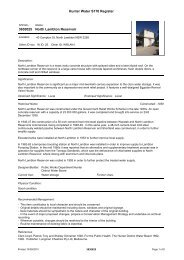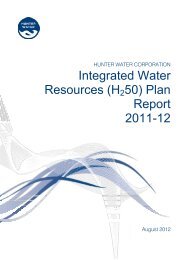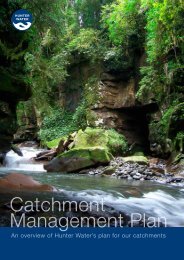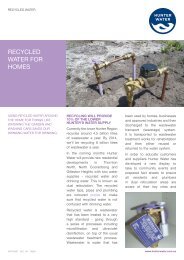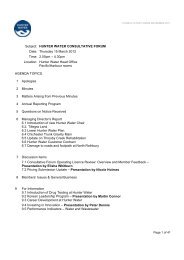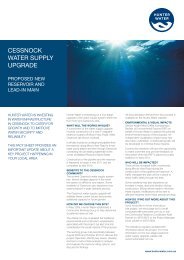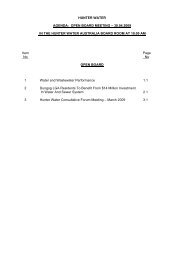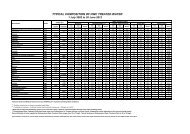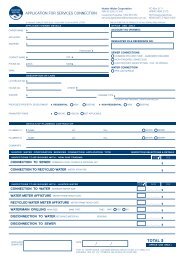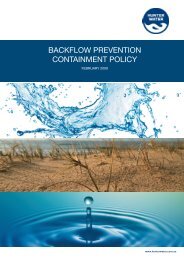Water Kit - Hunter Water
Water Kit - Hunter Water
Water Kit - Hunter Water
Create successful ePaper yourself
Turn your PDF publications into a flip-book with our unique Google optimized e-Paper software.
Impacts on groundwater<br />
quality in the hunter<br />
Groundwater is vulnerable to human<br />
impacts. Even small changes to the<br />
groundwater catchment can create a<br />
slow but significant change to water<br />
quality and quantity over time.<br />
There are a variety of impacts on<br />
groundwater management, including:<br />
• <strong>Water</strong> extraction: overuse of<br />
groundwater can affect the level<br />
of water stocks and potentially<br />
remove the natural buffer between<br />
the aquifer and saline sea water,<br />
allowing a flow of sea water into the<br />
freshwater sandbeds.<br />
• Industrial land use: industrial<br />
development can result in<br />
deforestation, water pollution and<br />
compaction of the sandbeds, and<br />
reduce the storage capacity and<br />
quality of the aquifer.<br />
• Urban development: pesticides<br />
and fertilizers used in urban areas<br />
can infiltrate the soil and move into<br />
the aquifer. Large areas of the land<br />
sealed as roads, roofs, driveways<br />
and paths cause a decrease in<br />
infiltration and thereby reduce<br />
replenishment of groundwater<br />
supplies.<br />
• Sewerage disposal: leaking septic<br />
tanks can seep into groundwater<br />
and cause contamination.<br />
• Mineral and sand mining: can<br />
cause damage to groundwater by<br />
exposing the water to the air. This<br />
begins as a series of chemical<br />
reactions which can result in ‘grey<br />
water’ and increased concentration<br />
of minerals, such as iron.<br />
Managing Groundwater in the<br />
Lower <strong>Hunter</strong><br />
The sustainable management of<br />
groundwater will ensure that this resource<br />
is available for continued human use, and<br />
remain an important factor in sustaining<br />
local ecosystems.<br />
Up until 1991, <strong>Hunter</strong> <strong>Water</strong> managed<br />
Tomago Sandbeds to provide water to<br />
Newcastle. Under <strong>Hunter</strong> <strong>Water</strong>’s<br />
management, some groundwater sources<br />
were classified as special areas and<br />
attract a high level of protection. In other<br />
areas licences were necessary to access<br />
a specified volume of water. These<br />
strategies ensured that the quality of<br />
water remained high.<br />
Since 1991 the management of the<br />
sandbeds has been controlled by the<br />
Department of Infrastructure, Planning<br />
and Natural Resources. New legislation<br />
empowered DIPNR to manage the<br />
resource to maximise benefits and<br />
minimise impacts.<br />
The <strong>Hunter</strong> <strong>Water</strong> (Special Areas<br />
Regulation came into effect in 2003,<br />
replacing the 1997 regulation. This<br />
regulation gives power to the Director<br />
General to issue directions for the<br />
management, disposal or removal of any<br />
substance that may harm any waters in<br />
the Special Area.<br />
The <strong>Water</strong> Management Licence issued<br />
to <strong>Hunter</strong> <strong>Water</strong> under the <strong>Water</strong> Act<br />
1912 is administered by DIPNR. The<br />
licence authorises <strong>Hunter</strong> <strong>Water</strong> to take<br />
and use water, and places rules on<br />
extractions from Chichester and the<br />
Williams River, and groundwater from<br />
Tomago and Tomaree Sandbeds.<br />
The licence requires <strong>Hunter</strong> <strong>Water</strong>’s<br />
management of water resources to<br />
follow the principles of sustainability<br />
and to manage its land in order to<br />
protect water quality. Management of<br />
the Sandbeds is guided by the<br />
following principles:<br />
• <strong>Water</strong> levels in the aquifer should<br />
be managed in a way that maintains<br />
the health of wetlands and other<br />
ecosystems<br />
• Unacceptable salt water intrusion<br />
is prevented by maintaining<br />
appropriate water levels<br />
• Unacceptable changes in the<br />
levels of chemical ions in the<br />
groundwater must be prevented<br />
• The amount of groundwater<br />
extracted annually should not<br />
exceed the average annual recharge<br />
(ie the amount of water entering the<br />
aquifer on average each year)<br />
• maintaining a management plan<br />
for the area<br />
Raw water is primarily extracted from the Inner Barrier zone<br />
<strong>Water</strong> from the sandbed is extracted by<br />
sinking bores underground<br />
<strong>Water</strong> kit . ssS . 001 . april 2010<br />
16




